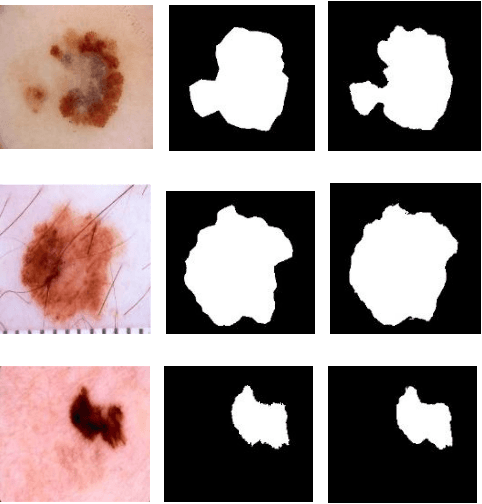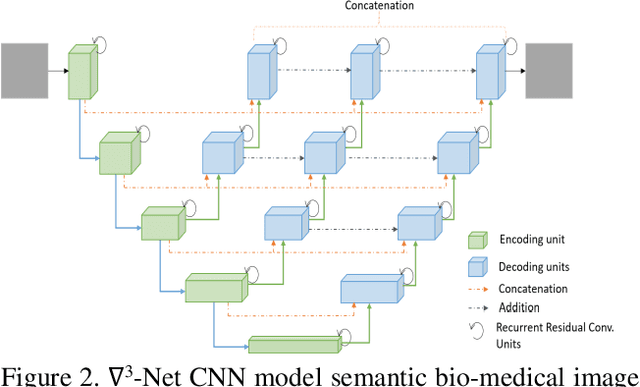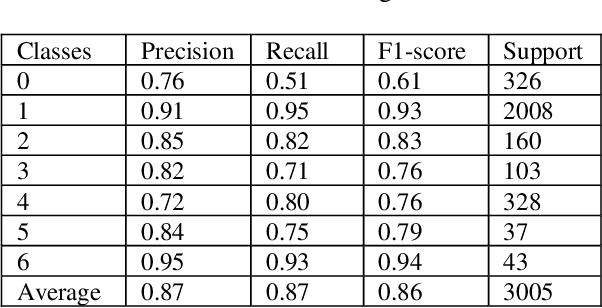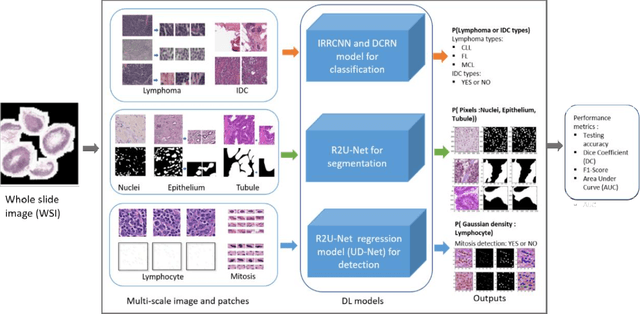Theus Aspiras
Skin Cancer Segmentation and Classification with NABLA-N and Inception Recurrent Residual Convolutional Networks
Apr 25, 2019



Abstract:In the last few years, Deep Learning (DL) has been showing superior performance in different modalities of biomedical image analysis. Several DL architectures have been proposed for classification, segmentation, and detection tasks in medical imaging and computational pathology. In this paper, we propose a new DL architecture, the NABLA-N network, with better feature fusion techniques in decoding units for dermoscopic image segmentation tasks. The NABLA-N network has several advances for segmentation tasks. First, this model ensures better feature representation for semantic segmentation with a combination of low to high-level feature maps. Second, this network shows better quantitative and qualitative results with the same or fewer network parameters compared to other methods. In addition, the Inception Recurrent Residual Convolutional Neural Network (IRRCNN) model is used for skin cancer classification. The proposed NABLA-N network and IRRCNN models are evaluated for skin cancer segmentation and classification on the benchmark datasets from the International Skin Imaging Collaboration 2018 (ISIC-2018). The experimental results show superior performance on segmentation tasks compared to the Recurrent Residual U-Net (R2U-Net). The classification model shows around 87% testing accuracy for dermoscopic skin cancer classification on ISIC2018 dataset.
Advanced Deep Convolutional Neural Network Approaches for Digital Pathology Image Analysis: a comprehensive evaluation with different use cases
Apr 19, 2019



Abstract:Deep Learning (DL) approaches have been providing state-of-the-art performance in different modalities in the field of medical imagining including Digital Pathology Image Analysis (DPIA). Out of many different DL approaches, Deep Convolutional Neural Network (DCNN) technique provides superior performance for classification, segmentation, and detection tasks. Most of the task in DPIA problems are somehow possible to solve with classification, segmentation, and detection approaches. In addition, sometimes pre and post-processing methods are applied for solving some specific type of problems. Recently, different DCNN models including Inception residual recurrent CNN (IRRCNN), Densely Connected Recurrent Convolution Network (DCRCN), Recurrent Residual U-Net (R2U-Net), and R2U-Net based regression model (UD-Net) have proposed and provide state-of-the-art performance for different computer vision and medical image analysis tasks. However, these advanced DCNN models have not been explored for solving different problems related to DPIA. In this study, we have applied these DCNN techniques for solving different DPIA problems and evaluated on different publicly available benchmark datasets for seven different tasks in digital pathology including lymphoma classification, Invasive Ductal Carcinoma (IDC) detection, nuclei segmentation, epithelium segmentation, tubule segmentation, lymphocyte detection, and mitosis detection. The experimental results are evaluated with different performance metrics such as sensitivity, specificity, accuracy, F1-score, Receiver Operating Characteristics (ROC) curve, dice coefficient (DC), and Means Squired Errors (MSE). The results demonstrate superior performance for classification, segmentation, and detection tasks compared to existing machine learning and DCNN based approaches.
 Add to Chrome
Add to Chrome Add to Firefox
Add to Firefox Add to Edge
Add to Edge